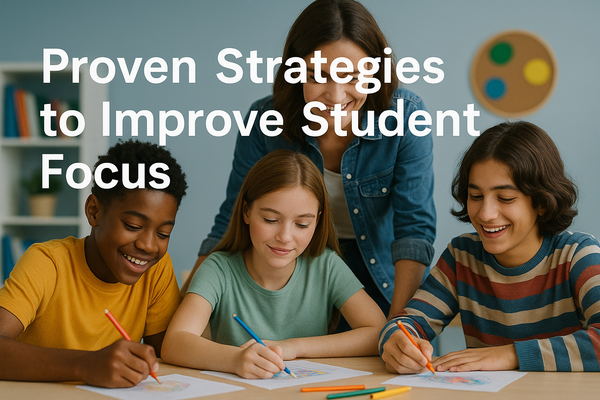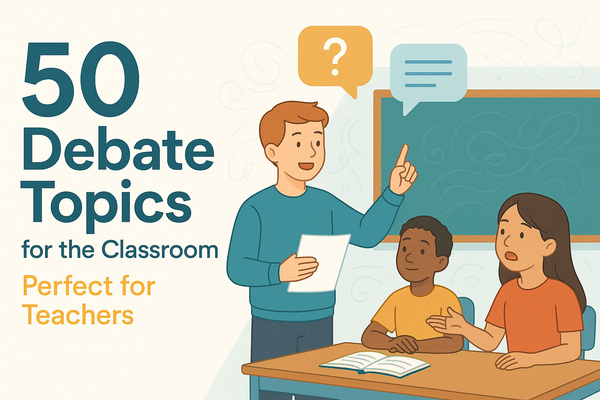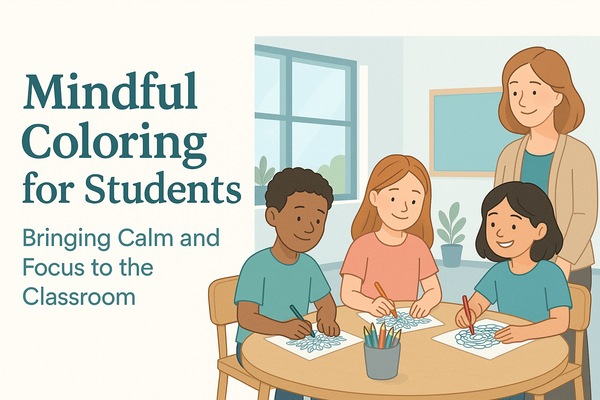Classroom Activities to Enhance Speaking and Listening Skills

Every teacher faces a moment where even clear instructions are followed by confusing behavior. It is a reminder that developing speaking and listening skills is important for classroom success. These skills help students build a strong connection with language and improve communication skills.
As a teacher, you can use speaking and listening activities to help students enhance their communication skills. Your students will be able to speak up and express their needs openly. We have curated a list of 10 engaging activities that you can use to help students enhance their skills.
10 Speaking and Listening Activities
Here are 10 engaging and creative speaking and listening activities to enhance your students’ skills.
1. Think-Pair-Share
Think-Pair-Share is a dynamic and highly effective activity designed to enhance students' speaking and listening skills. Students are given a question to think about individually and process their thoughts. After a brief reflection, students then pair up with a classmate.
In their pairs, students take turns sharing their thoughts, ensuring that both participants engage in listening and speaking. Finally, the class comes together for a larger discussion, allowing each pair to share what they discussed.
This activity is invaluable for building speaking and listening skills because it gives students multiple opportunities to express themselves in a low-pressure, supportive environment. Overall, the activity boosts confidence in communication.
2. Collaborative Group Work
Collaborative Group Work is a powerful strategy to enhance students' speaking and listening skills. In this activity, students are assigned group projects or tasks that require them to collaborate, communicate ideas, and listen actively to one another.
It is essential to establish clear guidelines and roles for the students ahead of time to ensure the success of Collaborative Group Work. This includes deciding how students will form groups, how roles will be assigned, and how participation will be managed and graded.
This activity helps develop speaking skills by encouraging students to articulate their thoughts and ideas in a group setting. It also enhances listening skills, as students must actively listen to their peers to contribute meaningfully to the discussion.
3. Socratic Seminars
Unlike traditional lectures, Socratic Seminars put students on the spot, encouraging them to take charge of the discussion, formulate their own ideas, and respond to their peers’ viewpoints. This approach promotes critical thinking, as students must carefully structure their thoughts before speaking.
Before the seminar, students are often asked to come up with their own questions related to the topic. This step ensures that they are actively engaged in the material and ready to contribute to the conversation.
Socratic Seminars are a powerful tool for developing speaking skills, as students are encouraged to express their ideas clearly and confidently in a respectful, open-ended dialogue. At the same time, these discussions promote listening skills, as students need to pay attention to others' arguments.
4. Literature Circles
Literature Circles are an engaging way to promote reading, speaking, and listening skills while also enhancing comprehension. In this activity, students are divided into small groups, with each group assigned a shared text to read together.
The goal is to encourage meaningful conversations about the text. Literature Circles help students refine their comprehension abilities by allowing them to reflect on and discuss the text in a supportive, interactive environment.
The collaborative nature of the activity fosters critical thinking and communication, which are essential for becoming strong readers, speakers, and listeners. This is a great activity to enhance speaking and listening skills. You can even use book review templates to help students structure everything before they share their ideas.
5. Podcasting
In a podcasting activity, students work together or individually to choose a topic, conduct research, write a script, and then record and present their content as an audio podcast. This multi-step process encourages students to think critically about their chosen topics.
The research step of this activity enhances their listening skills, as students will have to go through multiple resources. Once the research is done and they have gathered the information they want to present, students need to focus on speaking abilities to present their ideas in an engaging way.
Podcasting activities are an excellent way to develop speaking and listening abilities in the real world. Students not only practice verbal communication by creating and presenting content but also actively listen as they evaluate sources.
6. Drama and Role-Playing
Drama and Role-Playing activities are excellent tools for enhancing speaking and listening skills, as they encourage students to step into different roles and communicate from diverse perspectives.
During role-playing, students are encouraged to actively listen to their peers' performances and respond appropriately, which strengthens their listening skills. They must pay close attention to the dialogue, body language, and emotional tone of the other participants to understand the scenario.
For speaking skills, role-playing and drama require students to use their voices, expressions, and body language to convey meaning, emotions, and ideas effectively. By taking on different roles, students practice presenting their thoughts in various contexts.
7. Storytelling
In a storytelling activity, students are given the opportunity to tell a personal story or narrate a poem, allowing them to practice structuring their thoughts in a coherent and engaging way. By sharing their own experiences, students learn how to captivate an audience.
The process begins with students brainstorming and organizing their thoughts, which helps them develop narrative skills. They learn to create a clear beginning, middle, and end and focus on details that make their story interesting and relatable.
This activity focuses on speaking and listening activities and helps students listen to each other’s stories with empathy and respect. This helps build relationships and create an interactive atmosphere in the classroom.
8. Language Games
Language Games such as Charades, Taboo, and Pictionary are fantastic ways to develop speaking and listening skills in a fun and interactive way. These games require students to communicate both verbally and non-verbally, which helps them practice different aspects of language and expression.
These language-based games create a lively, interactive environment where students can practice listening skills by paying attention to their peers' verbal and non-verbal cues. At the same time, they develop speaking skills by conveying ideas in creative ways
9. Hot Seat
Hot Seat is an engaging activity that promotes both speaking and listening skills in an interactive and fun way. In this activity, one student is chosen to sit in the "hot seat," and the rest of the class takes turns asking them questions about a particular topic.
This activity helps develop speaking skills by encouraging the student in the hot seat to structure their thoughts clearly and respond to a variety of questions. It challenges the student to think on their feet.
For listening skills, the students asking the questions must pay close attention to the answers given, as they may need to ask follow-up questions or engage in further discussion based on what has been said. To help you organize this activity, here is a list of 50 Hot Seat Questions for the Classroom.
10. Speaking in Rhyme
Speaking in Rhyme is a playful and effective way to help students build their speaking and listening skills while boosting their confidence. The activity is designed to be engaging and open-ended, where students explore rhyming words and their creative possibilities.
This activity strengthens speaking skills by encouraging students to articulate their thoughts confidently while also making speaking feel less intimidating. It allows them to focus on the fun of language rather than the pressure of formal speech, making it easier for them to express themselves.
For listening skills, the activity encourages students to pay close attention to the rhymes and the variations created by their peers. In a group setting, students must listen carefully to each other’s rhymes, responding and building upon each other’s ideas. You should also explore some fun and easy rhyming words to make the activity fun.
Key Goals of Speaking and Listening Standards
Speaking and listening skills are essential for student success, not only in the classroom but also in the real world. Here is a closer look at the main goals of helping students enhance these skills.
Building Understanding
Students should actively engage in conversations, discussions, and group work where they exchange ideas and learn from others. This includes listening carefully, responding thoughtfully, and understanding different perspectives.
Sharing Ideas
Presenting information clearly and confidently is a big part of these standards. Students learn how to organize their thoughts and use tools like visuals, slides, or even videos to make their presentations more impactful.
Exploring Stories and Texts
Through reading and discussing literature, students dive into stories, poems, and plays to uncover their deeper meanings. They learn how to analyze characters, themes, and language and use evidence to support their interpretations.
Working Together
Collaboration is a cornerstone of the speaking and listening standards. Students practice listening actively, asking thoughtful questions, and working together on projects.
How Often Should You Incorporate Speaking and Listening Activities?
Consistency is key in developing students' speaking and listening skills. It is important to integrate them regularly into your teaching routine to maximize the benefits of these activities. Ideally, speaking and listening exercises should be a daily part of your classroom, even if only for a short period. This consistent practice allows students to build their confidence, enhance their communication skills, and retain what they have learned more effectively.
Tips to Organize Your Classroom Environment for Speaking and Listening Activities
Here are some practical tips to set your classroom up for success.
- Before starting any activity, demonstrate how students should move, speak, and listen during the exercise.
- Show them what appropriate volume levels and respectful interactions look like before, during, and after the activity.
- If the activity involves transitioning between partners or groups, use a timer to keep things on track.
- Incorporate music during transitions to make the environment more lively and engaging.
- Reduce the pressure on students to come up with responses on the spot by using guided templates.
- Engage students by allowing them to discuss topics they are passionate about or choose their own discussion prompts.
- Post sentence starters on the board or provide them as handouts to help students frame their responses.
By implementing these strategies, you can create a classroom environment that encourages active participation, meaningful communication, and a positive atmosphere for speaking and listening activities. To enhance the overall management of the classroom, you can implement these classroom management strategies.
Conclusion
Empowering students with strong speaking and listening skills last a lifetime. Whether through fun activities, collaborative projects, or meaningful discussions, these practices enhance communication and build confidence and connection.




